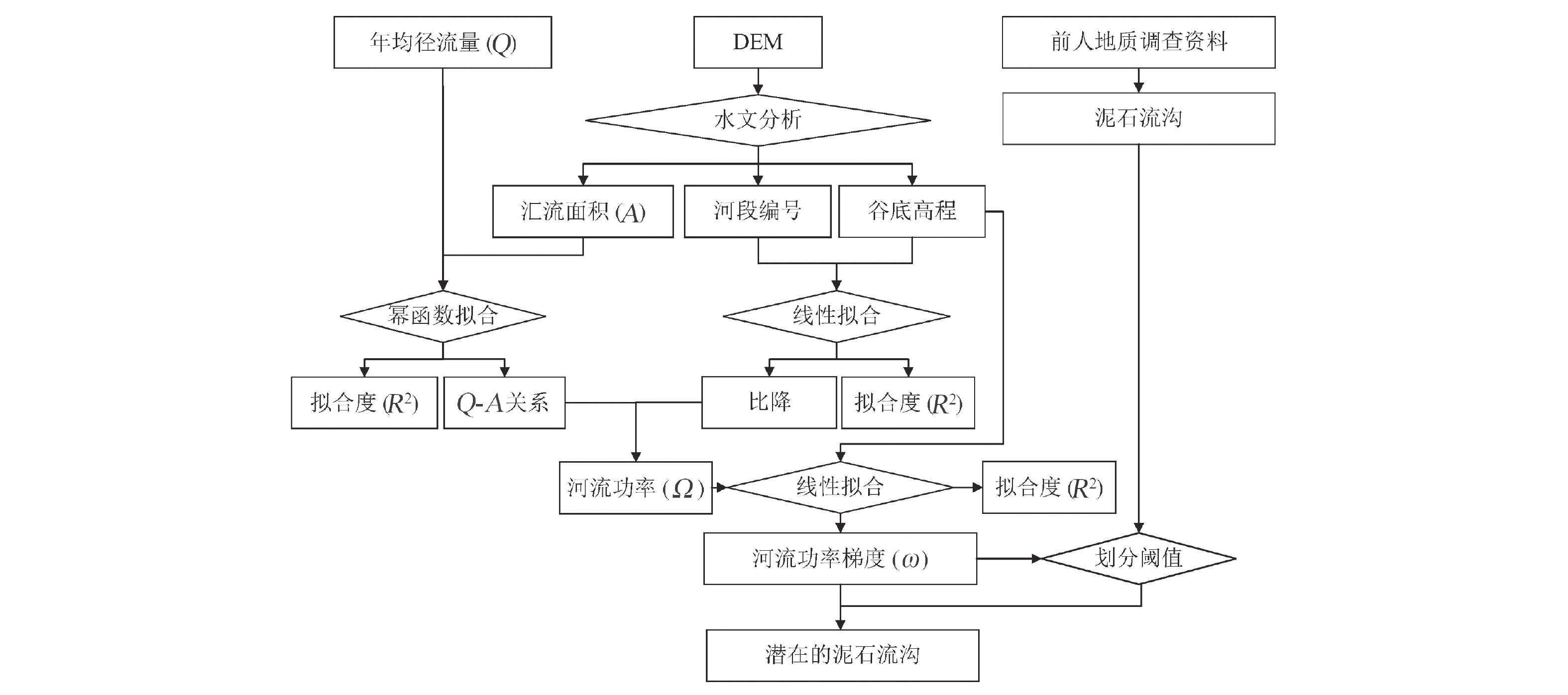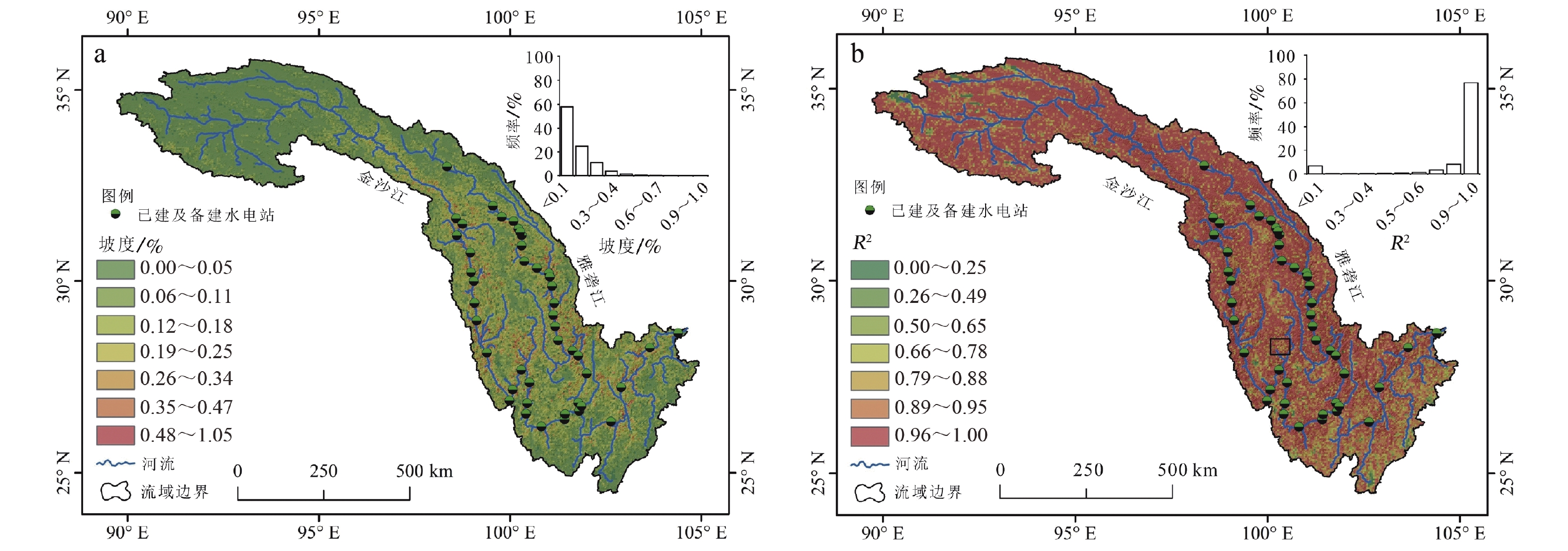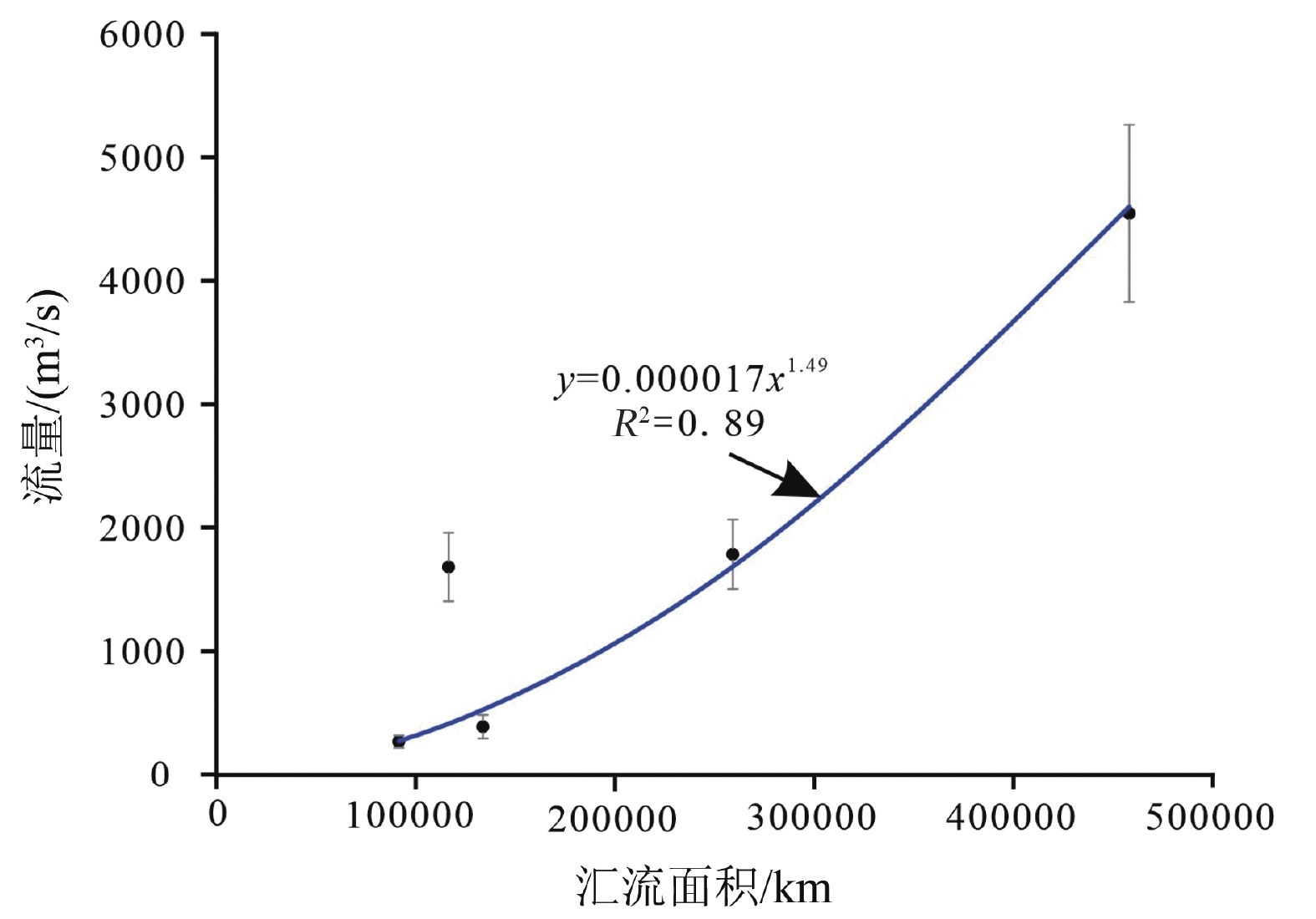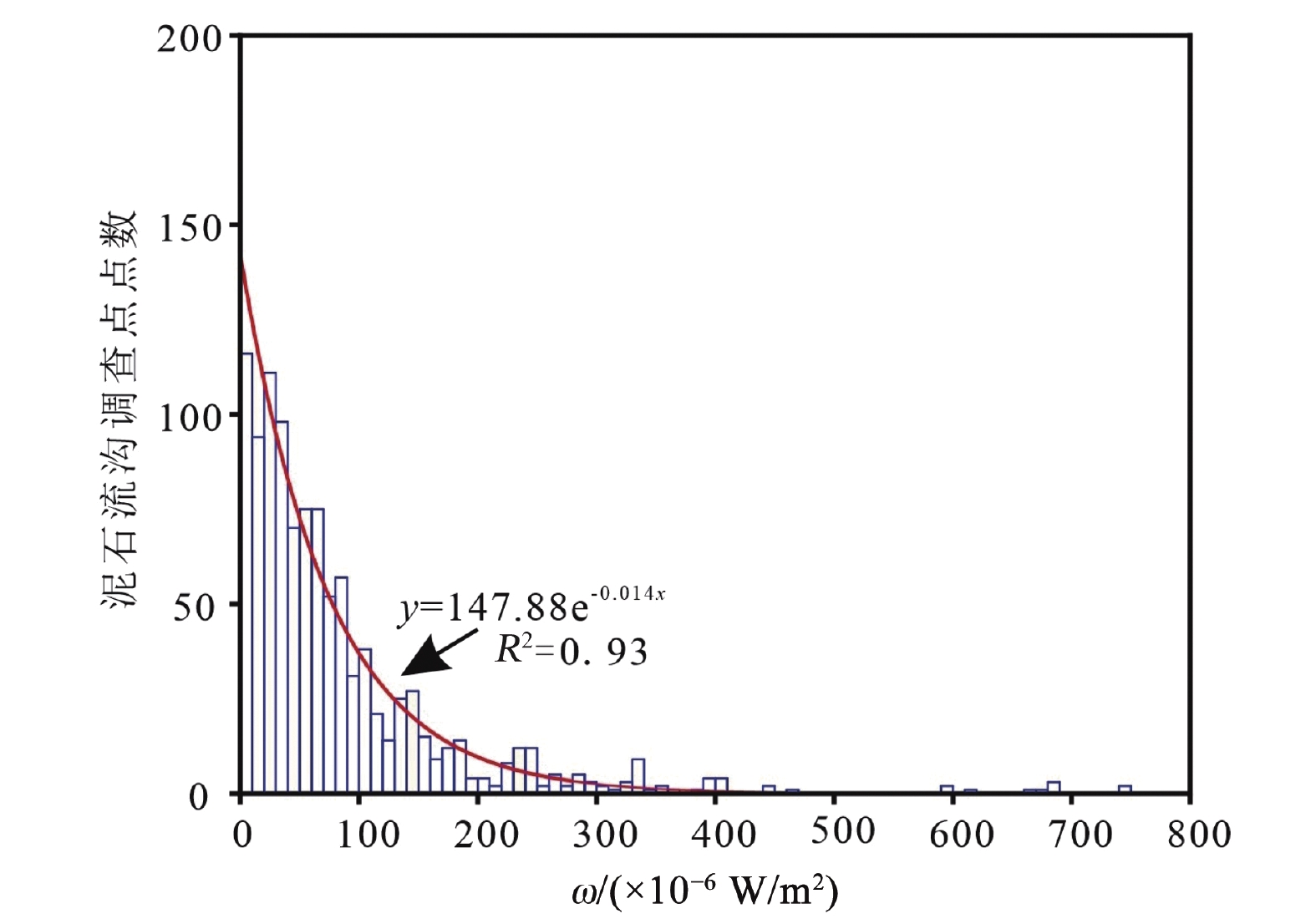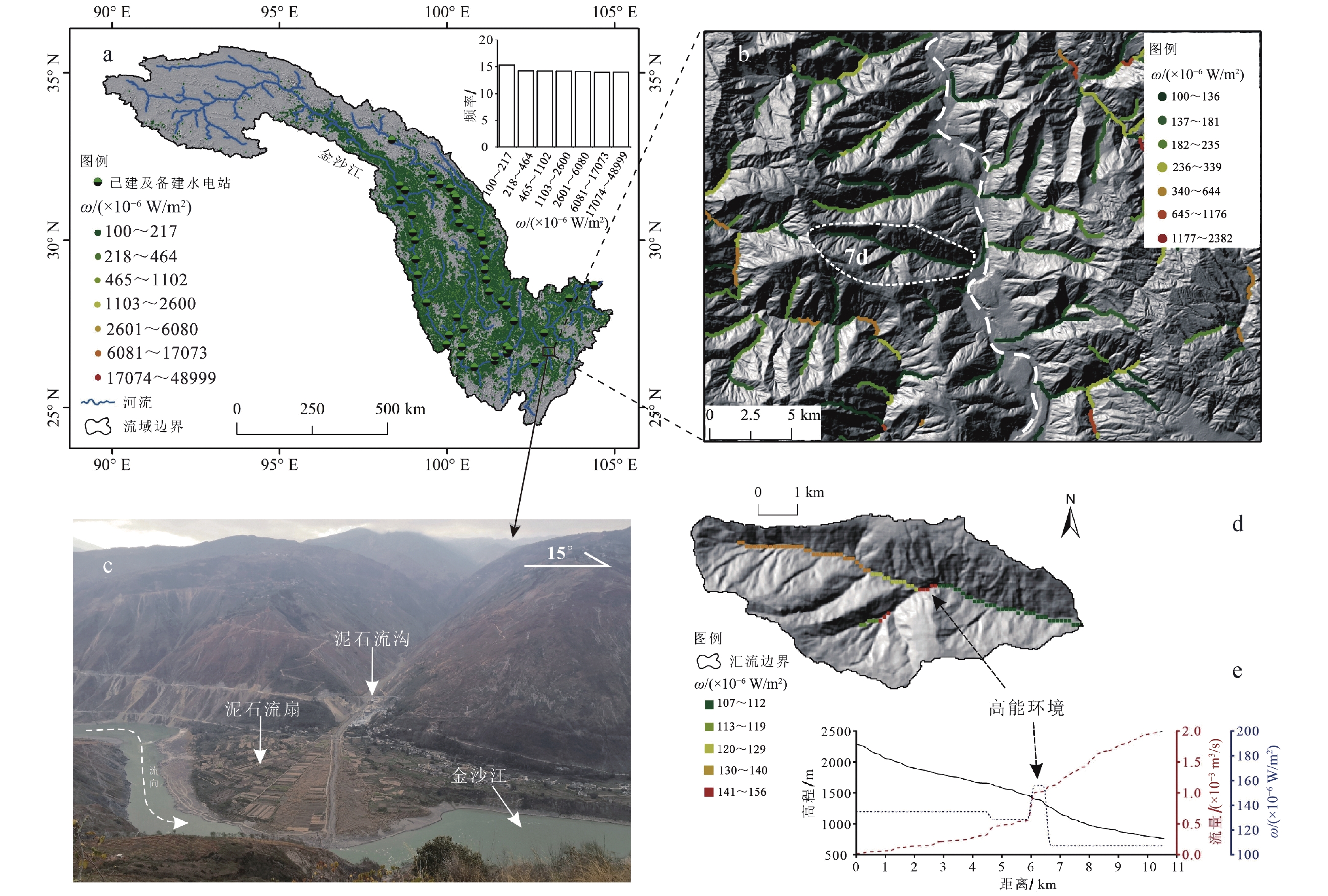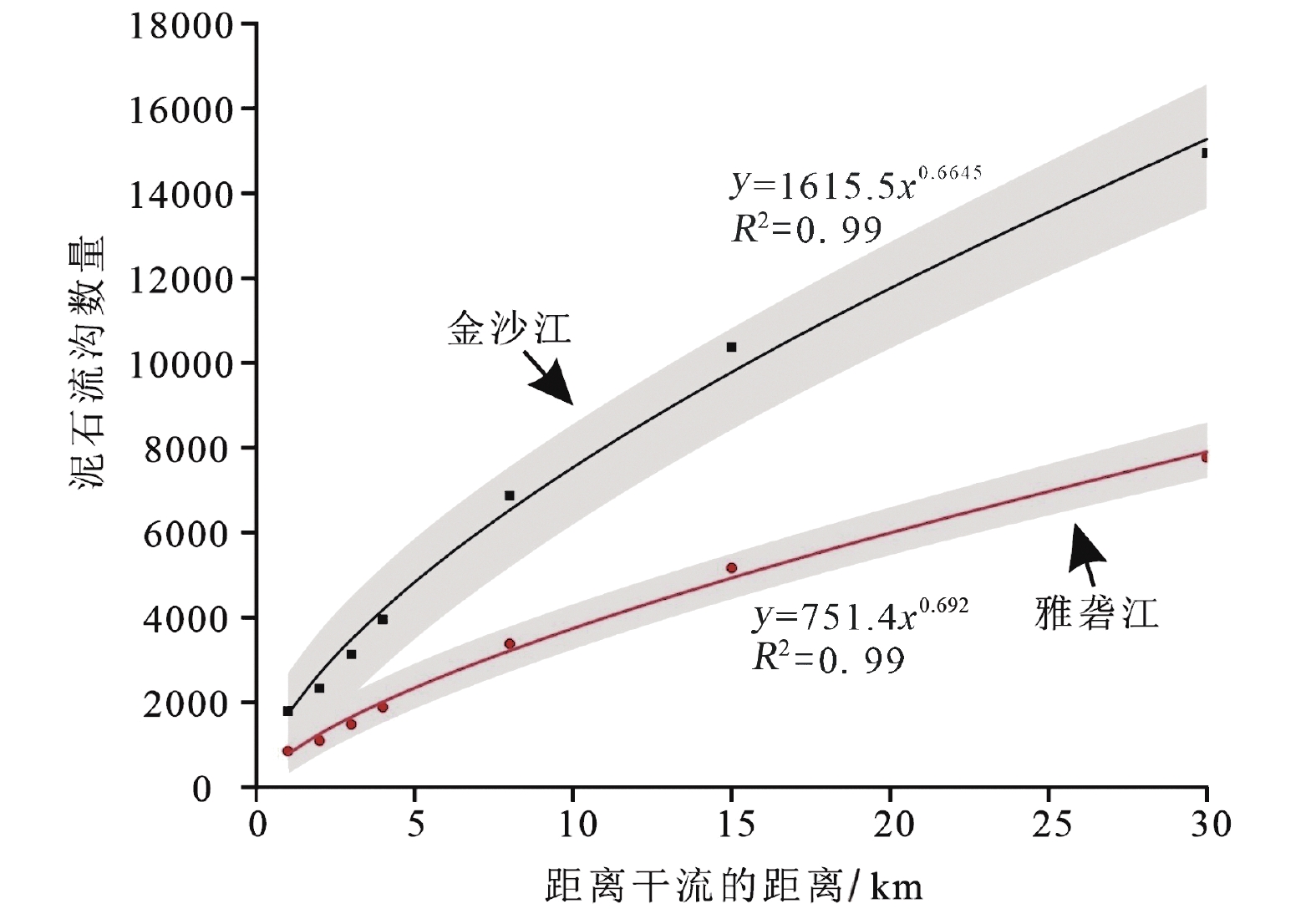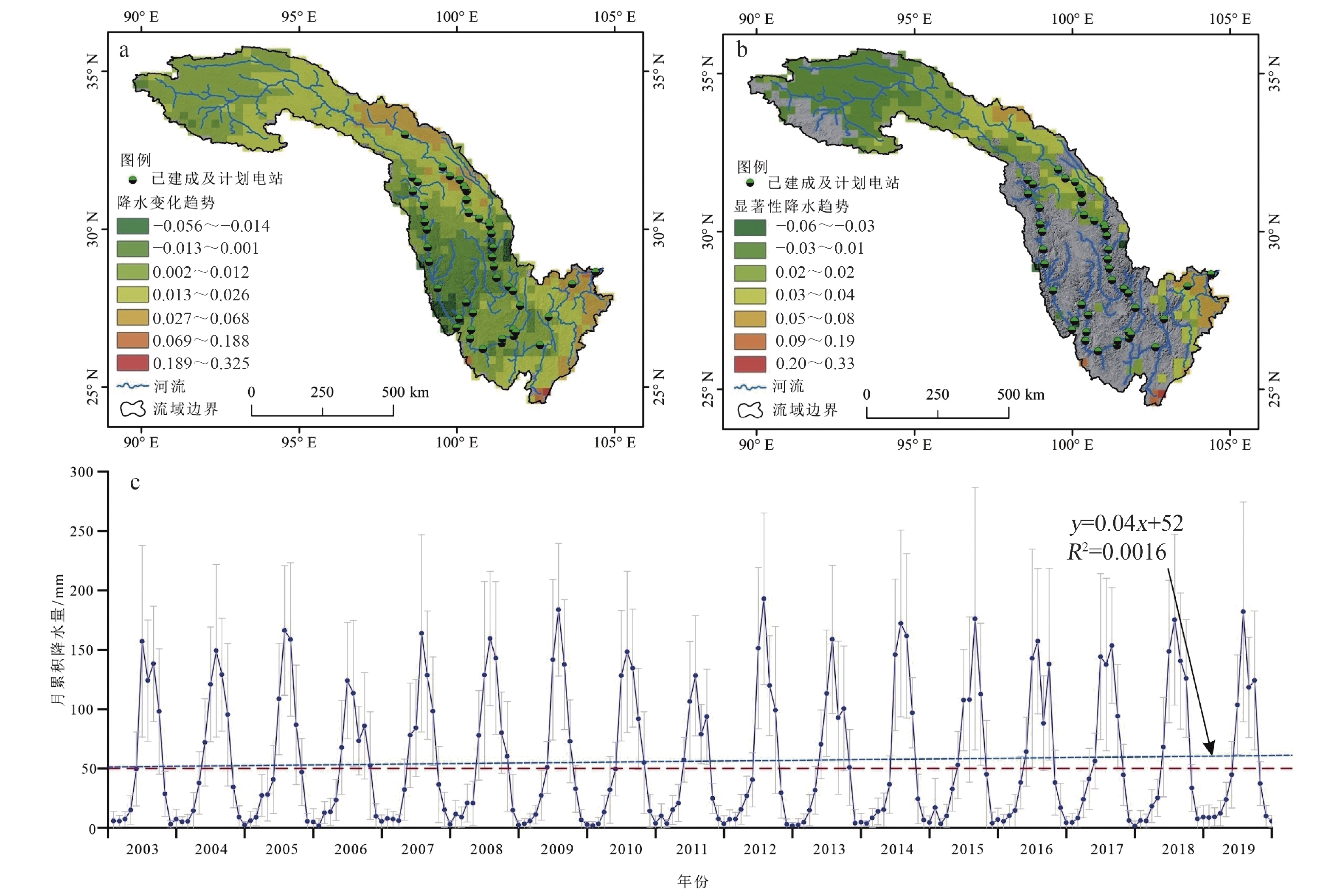Applying stream power gradient in the investigation on spatial susceptibility of debris flow: A case of the Jinsha River Basin, China
-
摘要:
泥石流空间易发程度调查是开展地质灾害防范和制定生态修复计划的基础之一。目前单纯依靠野外调查并结合遥感观测,或以小流域为单元的泥石流模拟,均难以在大空间范围内高效、准确地识别潜在泥石流沟。鉴于泥石流是一种高能重力流,此次研究以金沙江流域为例,在假定物源供给无差异条件下,提出通过求算河流功率梯度(ω)来实现地表外动力活动强度定量刻画和泥石流空间易发程度调查的新方案,并将泥石流沟验证点数与ω值关系曲线的比降趋势突变位置作为阈值(1×10−4 W/m²),提取出大约3.2万条长度超过200 m的高能河谷或泥石流易发沟谷。这些沟谷基本位于金沙江和雅砻江干流中下游,在大约30 km距离的缓冲区范围内密集分布,其数量与缓冲区宽度存在乘幂函数关系。在全球变暖背景下,未来发生极端气象事件可能性趋于增加,这些地带,尤其是梯级库区河段应做为泥石流灾害的重点防范区。研究的最终结果提供了金沙江流域泥石流易发沟谷的空间位置及ω值的点阵数据集,可供检索高能河谷的准确位置,也可作为相关地质灾害与地表过程研究的基础数据和资料。
Abstract:Investigation of spatial susceptibility of debris flow is a basis for carrying out geological hazard prevention and developing ecological restoration plans. It is difficult to efficiently and accurately identify potential debris flow gullies on a large spatial scale simply by relying on field surveys combined with remote sensing observations or debris flow simulations with small watersheds as units. Taking the Jinsha River Basin of China as an example, we propose a quantitative scheme to describe the intensity of extrinsic forces by calculating the stream power gradient (ω). We extracted gullies prone to debris flow, assuming that there is no spatial heterogeneity in the provenance supply conditions based on the fundamental understanding that debris flow is a high-energy gravity flow. In the situation where the threshold (ω=1×10−4 W/m²) is the mutational site of the gradient change trend of the relation curve between the number of debris flow gullies and ω value, a total of about 32 thousand debris flow gullies with lengths of more than 200 m were found. In the middle and lower reaches of the basin, these gullies are located within a 30-kilometer buffer zone along the Jinsha and Yalong Rivers, and there is a power function relationship between the number of debris flow gullies and the width of a buffer zone. However, extreme weather events are likely to increase in the future under global warming, and these areas should be the critical prevention areas of debris flow disasters, especially the cascade reservoir area. The results of this study provide a lattice data set of spatial locations of the gullies prone to debris flow and the stream power gradients in the Jinsha River basin, which can be used to retrieve the exact location of the high-energy gullies and can also be used as the basic data for the study of related geological hazards and surface processes in general.
-
Key words:
- debris flow /
- stream power /
- external force /
- high-energy valley /
- Jinsha River /
- geohazards
-

-
BADOUX A, GRAF C, RHYNER J, et al. , 2009. A debris-flow alarm system for the Alpine Illgraben catchment: design and performance[J]. Natural Hazards, 49(3): 517-539. doi: 10.1007/s11069-008-9303-x
BAGNOLD R A, 1960. Sediment discharge and stream power: A preliminary announcement[R]. Reston: U. S. Geological Survey.
CHEN J, DAI F C, YAO X, 2008. Holocene debris-flow deposits and their implications on the climate in the upper Jinsha River valley, China[J]. Geomorphology, 93(3-4): 493-500. doi: 10.1016/j.geomorph.2007.03.011
CHENG H L, HUANG Y, ZHANG W J, et al. , 2022. Physical process-based runout modeling and hazard assessment of catastrophic debris flow using SPH incorporated with ArcGIS: a case study of the Hongchun gully[J]. CATENA, 212: 106052. doi: 10.1016/j.catena.2022.106052
China Academy of Geological Environment Monitoring, 2018. Distribution map of collapse, landslide and debris flow in China[M]. Beijing: Geology Press.
China Institute of Geological Environment Monitoring, 2018. Distribution map of collapses, landslides and debris flows in China[M]//. Beijing: Geological Publishing House. (in Chinese)
COE J A, KINNER D A, GODT J W, 2008. Initiation conditions for debris flows generated by runoff at Chalk Cliffs, central Colorado[J]. Geomorphology, 96(3-4): 270-297. doi: 10.1016/j.geomorph.2007.03.017
CROWLEY J K, HUBBARD B E, MARS J C, 2003. Analysis of potential debris flow source areas on Mount Shasta, California, by using airborne and satellite remote sensing data[J]. Remote Sensing of Environment, 87(2-3): 345-358. doi: 10.1016/j.rse.2003.08.003
DI B F, CHEN N S, CUI P, et al. , 2008. GIS-based risk analysis of debris flow: an application in Sichuan, southwest China[J]. International Journal of Sediment Research, 23(2): 138-148. doi: 10.1016/S1001-6279(08)60013-X
FINLAYSON D P, MONTGOMERY D R, 2003. Modeling large-scale fluvial erosion in geographic information systems[J]. Geomorphology, 53(1-2): 147-164. doi: 10.1016/S0169-555X(02)00351-3
GAO J M, SANG Y H, 2017. Identification and estimation of landslide-debris flow disaster risk in primary and middle school campuses in a mountainous area of Southwest China[J]. International Journal of Disaster Risk Reduction, 25: 60-71. doi: 10.1016/j.ijdrr.2017.07.012
GAO Y, LI B, FENG Z, et al. , 2017. Global climate change and geological disaster response analysis[J]. Journal of Geomechanics, 23(1): 65-77. (in Chinese with English abstract)
GU Z K, SHI C X, PEN J, 2019. Evolutionary dynamics of the main-stem longitudinal profiles of ten kongdui basins within Inner Mongolia, China[J]. Journal of Geographical Sciences, 29(3): 417-431. doi: 10.1007/s11442-019-1607-0
HU G S, CHEN N S, LI J, et al. , 2014. Research on dynamic characteristics and development tendency of debris flow near field region in Baihetan Hydropower station, Jinshajiang River[J]. Research of Soil and Water Conservation, 21(2): 238-245. (in Chinese with English abstract)
HU G S, CHEN N S, TANOLI J I, et al. , 2017. Debris flow susceptibility analysis based on the combined impacts of antecedent earthquakes and droughts: a case study for cascade hydropower stations in the upper Yangtze River, China[J]. Journal of Mountain Science, 14(9): 1712-1727. doi: 10.1007/s11629-017-4375-1
HU G S, TIAN S F, CHEN N S, et al. , 2020. An effectiveness evaluation method for debris flow control engineering for cascading hydropower stations along the Jinsha River, China[J]. Engineering Geology, 266: 105472. doi: 10.1016/j.enggeo.2019.105472
HÜRLIMANN M, COVIELLO V, BEL C, et al. , 2019. Debris-flow monitoring and warning: review and examples[J]. Earth-Science Reviews, 199: 102981. doi: 10.1016/j.earscirev.2019.102981
IMAIZUMI F, MASUI T, YOKOTA Y, et al. , 2019. Initiation and runout characteristics of debris flow surges in Ohya landslide scar, Japan[J]. Geomorphology, 339: 58-69. doi: 10.1016/j.geomorph.2019.04.026
IPCC, 2014. Climate Change 2014: impacts, adaptation and vulnerability: Part A: global and sectoral aspects[R]. Cambridge: Cambridge University Press.
LEA D M, LEGLEITER C J, 2016. Mapping spatial patterns of stream power and channel change along a gravel-bed river in northern Yellowstone[J]. Geomorphology, 252: 66-79. doi: 10.1016/j.geomorph.2015.05.033
LI D F, LU X X, YANG X K, et al. , 2018. Sediment load responses to climate variation and cascade reservoirs in the Yangtze River: a case study of the Jinsha River[J]. Geomorphology, 322: 41-52. doi: 10.1016/j.geomorph.2018.08.038
LI W L, ZHU J, GONG Y H, et al. , 2022. An optimal selection method for debris flow scene symbols considering public cognition differences[J]. International Journal of Disaster Risk Reduction, 68: 102698. doi: 10.1016/j.ijdrr.2021.102698
LI Y C, CHEN J P, ZHOU F J, et al. , 2020. Identification of ancient river-blocking events and analysis of the mechanisms for the formation of landslide dams in the Suwalong section of the upper Jinsha River, SE Xizang Plateau[J]. Geomorphology, 368: 107351. doi: 10.1016/j.geomorph.2020.107351
LIU J J, LI Y, SU P C, et al. , 2009. Temporal variation of intermittent surges of debris flow[J]. Journal of Hydrology, 365(3-4): 322-328. doi: 10.1016/j.jhydrol.2008.12.005
LIU M, CHEN N S, ZHAO C Y, 2018. Influence of fault structure on debris flow in Qiaojia and Menggu section of the Jinsha River[J]. Journal of Natural Disasters, 27(3): 136-143. (in Chinese with English abstract)
LIU X W, XU J J, HAN Z M, 2016. Analysis on spatial-temporal distribution of precipitation in Jinsha River Basin and variation trend[J]. Yangtze River, 47(15): 36-44. (in Chinese with English abstract)
LONG K, ZHANG S J, WEI F Q, et al. , 2020. A hydrology-process based method for correlating debris flow density to rainfall parameters and its application on debris flow prediction[J]. Journal of Hydrology, 589: 125124. doi: 10.1016/j.jhydrol.2020.125124
LU C H, DONG X Y, TANG J L, et al. , 2019. Spatio-temporal trends and causes of variations in runoff and sediment load of the Jinsha River in China[J]. Journal of Mountain Science, 16(10): 2361-2378. doi: 10.1007/s11629-018-5330-6
LU J Y, YU G A, HUANG H Q, 2021. Research and prospect on formation mechanism of debris flows in high mountains under the influence of climate change[J]. Journal of Glaciology and Geocryology, 43(2): 555-567. (in Chinese with English abstract)
LYU L, XU M Z, WANG Z Y, et al. , 2022. A field investigation on debris flows in the incised Tongde sedimentary basin on the northeastern edge of the Xizang Plateau[J]. CATENA, 208: 105727. doi: 10.1016/j.catena.2021.105727
MA L F, 2002. Geological atlas of China[M]. Beijing: Geology Press.
MCCOY S W, COE J A, KEAN J W, et al. , 2011. Observations of debris flows at Chalk Cliffs, Colorado, USA: Part 1, in-situ measurements of flow dynamics, tracer particle movement and video imagery from the summer of 2009[J]. Italian Journal of Engineering Geology and Environment, 759-768,doi: 10.4408/IJEGE.2011-03.B-083.
Ministry of Land and Resources of the People's Republic of China, 2006. Specification of geological investigation for debris flow stabilization: DZ/T 0220-2006[S]. Beijing: Standards Press of China. (in Chinese)
MONTGOMERY D R, GRAN K B, 2001. Downstream variations in the width of bedrock channels[J]. Water Resources Research, 37(6): 1841-1846. doi: 10.1029/2000WR900393
NIKOLOPOULOS E I, CREMA S, MARCHI L, et al. , 2014. Impact of uncertainty in rainfall estimation on the identification of rainfall thresholds for debris flow occurrence[J]. Geomorphology, 221: 286-297. doi: 10.1016/j.geomorph.2014.06.015
OHMORI H, 1991. Change in the mathematical function type describing the longitudinal profile of a river through an evolutionary process[J]. The Journal of Geology, 99(1): 97-110. doi: 10.1086/629476
OHMORI H, SAITO K, 1993. Morphological development of longitudinal profiles of rivers in Japan and Taiwan[J]. Bulletin of the Department of Geography, University of Tokyo(25): 29-41.
OORTHUIS R, HÜRLIMANN M, ABANCÓ C, et al. , 2021. Monitoring of rainfall and soil moisture at the rebaixader catchment (Central Pyrenees)[J]. Environmental & Engineering Geoscience, 27(2): 221-229.
PÉREZ-PEñA J V, AZAñÓN J M, AZOR A, et al. , 2009. Spatial analysis of stream power using GIS: SLK anomaly maps[J]. Earth Surface Processes and Landforms, 34(1): 16-25. doi: 10.1002/esp.1684
QIN Y L, WU J L, ZHAN H Y, et al. , 2021. Discussion on the correlation between active fault and geological disaster distribution in the Ganzi area, western Sichuan province, China[J]. Journal of Geomechanics, 27(3): 463-474. (in Chinese with English abstract)
QIU C C, SU L J, ZOU Q, et al. , 2022. A hybrid machine-learning model to map glacier-related debris flow susceptibility along Gyirong Zangbo watershed under the changing climate[J]. Science of the Total Environment, 818: 151752. doi: 10.1016/j.scitotenv.2021.151752
RãDOANE M, RãDOANE N, DUMITRIU D, 2003. Geomorphological evolution of longitudinal river profiles in the Carpathians[J]. Geomorphology, 50(4): 293-306. doi: 10.1016/S0169-555X(02)00194-0
SCHMIDT A H, DENN A R, HIDY A J, et al. , 2019. Human and natural controls on erosion in the Lower Jinsha River, China[J]. Journal of Asian Earth Sciences, 170: 351-359. doi: 10.1016/j.jseaes.2018.10.017
STRUTH L, GARCIA-CASTELLANOS D, VIAPLANA-MUZAS M, et al. , 2019. Drainage network dynamics and knickpoint evolution in the Ebro and Duero basins: from endorheism to exorheism[J]. Geomorphology, 327: 554-571. doi: 10.1016/j.geomorph.2018.11.033
SUMMERFIELD M A, 1991. Global Geomorphology[M]. London: Routledge.
TSUNETAKA H, HOTTA N, IMAIZUMI F, et al. , 2021. Variation in rainfall patterns triggering debris flow in the initiation zone of the Ichino-sawa torrent, Ohya landslide, Japan[J]. Geomorphology, 375: 107529. doi: 10.1016/j.geomorph.2020.107529
WANG Q, KONG Y Y, ZHANG W, et al. , 2016. Regional debris flow susceptibility analysis based on principal component analysis and self-organizing map: a case study in Southwest China[J]. Arabian Journal of Geosciences, 9(18): 718. doi: 10.1007/s12517-016-2752-8
WANG Z B, WANG J Y, HE L L, et al. , 2021. Characteristics and evolution process of the ridge-groove sequence of the Jiulongtan glacial accumulation in Mengshan, Shandong: with the discussion on the difference of accumulation sequence of glacier and debris flow[J]. Journal of Geomechanics, 27(1): 105-116. (in Chinese with English abstract)
WEI L, HU K H, LIU S, 2021. Spatial distribution of debris flow-prone catchments in Hengduan mountainous area in southwestern China[J]. Arabian Journal of Geosciences, 14(23): 2650. doi: 10.1007/s12517-021-08818-1
WEN L, WEI P F, LI X M, et al. , 2020. Study on the river network, geomorphological features and tectonic activity in the Danjiangkou reservoir and its surrounding areas[J]. Journal of Geomechanics, 26(2): 252-262. (in Chinese with English abstract)
WU S E, CHEN J, ZHOU W, et al. , 2019. A modified Logit model for assessment and validation of debris-flow susceptibility[J]. Bulletin of Engineering Geology and the Environment, 78(6): 4421-4438. doi: 10.1007/s10064-018-1412-5
WU Y M, LAN H X, 2020. Debris flow analyst (DA): a debris flow model considering kinematic uncertainties and using a GIS platform[J]. Engineering Geology, 279: 105877. doi: 10.1016/j.enggeo.2020.105877
WU Y Y, FANG H W, HUANG L, et al. , 2020. Changing runoff due to temperature and precipitation variations in the dammed Jinsha River[J]. Journal of Hydrology, 582: 124500. doi: 10.1016/j.jhydrol.2019.124500
XIONG M Q, MENG X M, WANG S Y, et al. , 2016. Effectiveness of debris flow mitigation strategies in mountainous regions[J]. Progress in Physical Geography: Earth and Environment, 40(6): 768-793. doi: 10.1177/0309133316655304
YANG W M, WU S R, ZHANG Y S, et al. , 2006. Formation conditions of slope type mudflow in Ningshaan county, southern Shaanxi, and its inducing mechanism[J]. Journal of Geomechanics, 12(2): 219-227. (in Chinese with English abstract)
ZHANG C S, ZHANG Y C, ZHANG L H, 2004. Danger assessment of collapses, landslides and debris flows of geological hazards in China[J]. Journal of Geomechanics, 10(1): 27-32. (in Chinese with English abstract)
ZHANG N, FANG Z W, HAN X, et al. , 2018. The study on temporal and spatial distribution law and cause of debris flow disaster in China in recent years[J]. Earth Science Frontiers, 25(2): 299-308. (in Chines with English abstract)
ZHAO W H, GAO Y, 2011. Analysis on annual and decadal runoff variation characteristics of Jinsha River Basin[J]. Yangtze River, 42(6): 98-100. (in Chines with English abstract)
ZHAO Y, MENG X M, QI T J, et al. , 2020. AI-based identification of low-frequency debris flow catchments in the Bailong River basin, China[J]. Geomorphology, 359: 107125. doi: 10.1016/j.geomorph.2020.107125
ZHAO Y M, DONG N P, LI Z S, et al. , 2021. Future precipitation, hydrology and hydropower generation in the Yalong River Basin: projections and analysis[J]. Journal of Hydrology, 602: 126738. doi: 10.1016/j.jhydrol.2021.126738
ZHOU W Q, QIU H J, WANG L Y, et al. , 2022. Combining rainfall-induced shallow landslides and subsequent debris flows for hazard chain prediction[J]. CATENA, 213: 106199. doi: 10.1016/j.catena.2022.106199
ZHU L, HE S M, QIN H K, et al. , 2021. Analyzing the multi-hazard chain induced by a debris flow in Xiaojinchuan River, Sichuan, China[J]. Engineering Geology, 293: 106280. doi: 10.1016/j.enggeo.2021.106280
ZHUO G, JIAN J, BIANBA C R, 2011. Runoff of the Jinsha River: characteristics and its response to climate change[J]. Journal of Glaciology and Geocryology, 33(2): 405-415. (in Chinese with English abstract)
高杨, 李滨, 冯振, 等, 2017. 全球气候变化与地质灾害响应分析[J]. 地质力学学报, 23(1): 65-77. doi: 10.3969/j.issn.1006-6616.2017.01.002
胡桂胜, 陈宁生, 李俊, 等, 2014. 金沙江白鹤滩水电站坝址近场区泥石流运动特征与发展趋势分析[J]. 水土保持研究, 21(2): 238-245. doi: 10.13869/j.cnki.rswc.2014.02.044
刘美, 陈宁生, 赵春瑶, 2018. 断裂构造对金沙江巧家至蒙姑段泥石流发育影响研究[J]. 自然灾害学报, 27(3): 136-143. doi: 10.13577/j.jnd.2018.0316
刘晓婉, 许继军, 韩志明, 2016. 金沙江流域降水空间分布特征及变化趋势分析[J]. 人民长江, 47(15): 36-44. doi: 10.16232/j.cnki.1001-4179.2016.15.008
鲁建莹, 余国安, 黄河清, 2021. 气候变化影响下高山区泥石流形成机制研究及展望[J]. 冰川冻土, 43(2): 555-567. doi: 10.7522/j.issn.1000-0240.2021.0043
秦宇龙, 吴建亮, 詹涵钰, 等, 2021. 川西甘孜地区活动断裂与地质灾害分布相关性探讨[J]. 地质力学学报, 27(3): 463-474. doi: 10.12090/j.issn.1006-6616.2021.27.03.042
王照波, 王江月, 何乐龙, 等, 2021. 山东蒙山九龙潭冰川堆积“垄槽序列”的特征及演化过程研究: 兼论冰川、泥石流堆积序列的差异性[J]. 地质力学学报, 27(1): 105-116. doi: 10.12090/j.issn.1006-6616.2021.27.01.011
文力, 魏鹏飞, 李学敏, 等, 2020. 丹江口水库库区及周边地区河网形态、地貌特征及构造活动性意义[J]. 地质力学学报, 26(2): 252-262. doi: 10.12090/j.issn.1006-6616.2020.26.02.024
杨为民, 吴树仁, 张永双, 等, 2006. 陕西宁陕县城坡面型泥石流形成条件及其诱发机制[J]. 地质力学学报, 12(2): 219-227. doi: 10.3969/j.issn.1006-6616.2006.02.015
张春山, 张业成, 张立海, 2004. 中国崩塌、滑坡、泥石流灾害危险性评价[J]. 地质力学学报, 10(1): 27-32. doi: 10.3969/j.issn.1006-6616.2004.01.004
张楠, 方志伟, 韩笑, 等, 2018. 近年来我国泥石流灾害时空分布规律及成因分析[J]. 地学前缘, 25(2): 299-308. doi: 10.13745/j.esf.yx.2017-5-10
赵文焕, 高袁, 2011. 金沙江流域径流年代际变化特性分析[J]. 人民长江, 42(6): 98-100. doi: 10.3969/j.issn.1001-4179.2011.06.027
中国地质环境监测院, 2018. 中国崩塌滑坡泥石流分布图[M]. 北京: 地质出版社.
中华人民共和国国土资源部, 2006. 泥石流灾害防治工程勘查规范: DZ/T 0220-2006[S]. 北京: 中国标准出版社.
卓嘎, 建军, 边巴次仁, 2011. 1960-2004年金沙江径流量特征及其对气候变化的响应[J]. 冰川冻土, 33(2): 405-415.
-



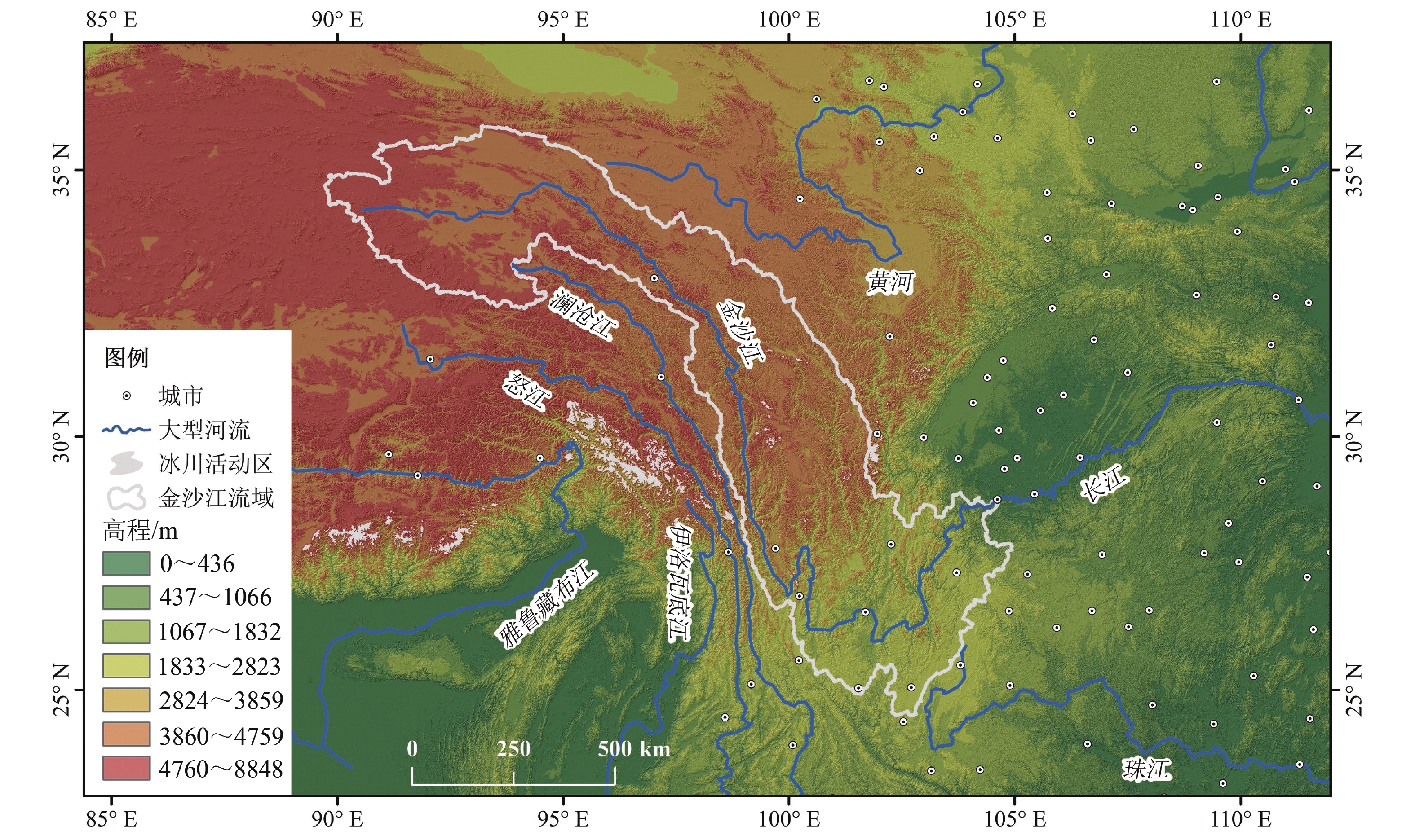
 下载:
下载:
